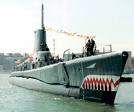|
USS Tench, SS-417, lead boat of Tench class
 The acronym GUPPY stands for Greater Underwater Propulsion Power. At the conclusion of WW-II, the United States was left with a very modern submarine fleet. Submarines captured from Germany demonstrated the feasibility of the snorkel system, which allowed for greater underwater speed and maneuverability. The acronym GUPPY stands for Greater Underwater Propulsion Power. At the conclusion of WW-II, the United States was left with a very modern submarine fleet. Submarines captured from Germany demonstrated the feasibility of the snorkel system, which allowed for greater underwater speed and maneuverability.
Essentially, the GUPPY I program meant streamlining exterior hull surfaces, increasing battery capacity, removal of deck guns, and compartment rearrangements. Almost immediately after these conversions, the GUPPY II program commenced, which added the installation of a snorkel system that allowed the diesel engines to be operated while the boat was at periscope depth. Twenty four boats were converted to GUPPY II, about half being Balao Class, and the remaining Tench Class. In 1951, 10 boats were to receive a GUPPY 1A conversion. This conversion was similar to the GUPPY II, but the equipment updates and re-arrangements were not as drastic.
The submarines of the Tench class were an improvement over the previous Gato and Balao classes due to better interior machinery and ballast tank arrangements. Twenty-five were completed for the United States during, or immediately following WW-II, though most never made a war patrol.
Specifications, USS Tench, SS-417:
Displacement (srf/sub tons): 1,570/2,414
Dimensions (L*B*D feet): 312`0*27`0*16`5
Propulsion: 4*GM Winton V-16 or 4*Fairbanks-Morse 10 cylinder diesel engine, 2*1,370 hp direct drive DC electric motors, 2 shafts
Speed (srf/sub knots): 20.25/8.75
Range (srf/sub n/miles@knots): 11,000
Diving depth (feet): 400
Complement: 10 officers 71 enlisted
Torpedo: 6*21" (533mm)bow torpedo tubes, 4*21" stern torpedo tubes, total of 24 torpedoes
Mines: none
Armament: 1*5"/25 main deck gun, 2*40mm AA gun, 2*0.5" machine gun
Back to History Index
|